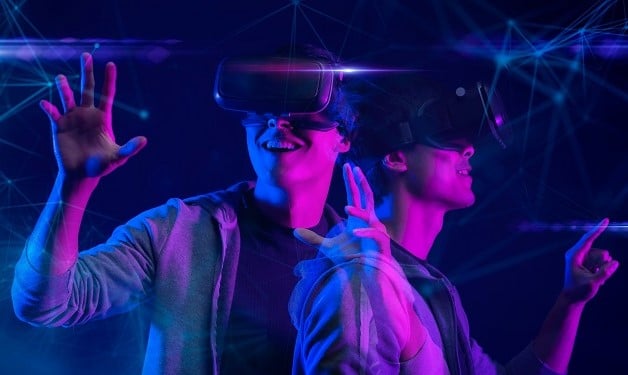The potential of the metaverse is staggering. The Dubai Future Foundation predicts that it could contribute $4 billion to the UAE’s annual GDP and create 40,000 jobs by 2030. At the 2022 Dubai Metaverse Assembly, James Hairston, director of AR/VR Policy at Meta, suggested that the metaverse could account for 6 percent of the MENA region’s GDP, or approximately $360 billion in the next decade.
The companies that are building the metaverse consider it the next iteration of the internet, and a possible catalyst for the Fourth Industrial Revolution. However, investors who have already sunk billions in metaverse projects are eagerly awaiting concrete results. Those who remain on the sidelines are equally anxious.
Read: Majid Al Futtaim launches first-ever metaverse mall in Dubai
Enormous potential
If you are interested in the metaverse, it’s important to recognize that the development of new technologies can be a slow process. They can take a surprisingly long time to arrive at their commercial potential, as evidenced by the examples of autonomous vehicles and Artificial Intelligence.
Technologies such as these are the result of an accumulation of incremental technological advances, and the metaverse is no different, being a combination of several top trends, including immersive reality, advanced connectivity, and AI.
Recently, at the Dubai Metaverse Assembly, the Crown Prince of Dubai and Chairman of the Dubai Executive Council Sheikh Hamdan bin Mohammed bin Rashid Al Maktoum launched the Dubai Metaverse Strategy. The aim of this strategy is to position Dubai as “one of the leading metaverse economies, and a major hub for the global metaverse community.”
At the event, companies like Emirates Airlines and DP World also discussed their plans to leverage the metaverse for internal functions like staff training and exploring its potential for providing a parallel revenue stream through virtual trade. Nike’s success in their virtual space in Roblox, Nikeland, is proof that there is potential for significant financial gain in the metaverse, having sold over $185 million of NFTs for digital sneakers and attracting over 26 million visitors.

Digital twin
Speaking in a panel discussion at the World Economic Forum (WEF) in Davos, Switzerland, the Saudi Minister of Communications and Information Technology Abdullah Alswaha pointed out that the kingdom was currently using the metaverse to help develop some of its largest infrastructure projects, specifically the NEOM and Red Sea projects.
The minister shared that Saudi Crown Prince Mohammed bin Salman had urged that all developments first be tested in the “digital twin” created in the metaverse before initiating production in the real world.
Alswaha said the use of the digital twin helped the country recreate projects in the metaverse, which in turn helped streamline planning and bring down costs.
“Within NEOM we promised we would be able to save 95 percent of the environment, and we were able to do that,” Alswaha said, adding that this method had also been used by Aramco and SABIC in projects to help reduce carbon emissions.
Not a fad
Christopher M. Reid, founder and lead visionary of goHere, says the concept of a metaverse, as in a virtual shared space where people can interact with one another as well as with digital objects, has been around for decades.
“The rise of new technologies such as AR/VR and blockchain have fueled the concept of the metaverse with major companies such as Microsoft and Meta understanding the long-term investment this space provides,” Reid adds.
Nick Curran, head of Endava Middle East and North Africa, says that as with any “hyped” technology, there is an accompanying degree of skepticism, even more so in the current economic climate where the ROI on every dollar spent is being questioned.
“Far from the hype, though, questions around the relevance of the metaverse arise not because of the limitations of the technology itself, but rather because it is often misunderstood,” Curran says, adding that if one were to ask a dozen different people to define the metaverse, they’d likely hear a dozen different answers.

Dive, dive, dive
What’s important, says Vasseh Ahmed, managing director for MENA at Enjinstarter, is that brands, cities, and countries have all recognized that the metaverse needs to be part of their customer engagement strategy.
“In the near term, the metaverse will continue to provide a dynamic customer engagement channel for brands and a public space for Web3 gaming and economic activity,” Ahmed adds. Moreover, he believes the transformative nature of the underlying technology will help create even more metaverse use cases.
“Over the next decade, the metaverse is likely to expand beyond gaming and socializing to include a wide range of applications, such as education, healthcare, commerce, and entertainment. It could become a new digital frontier, with opportunities for creators, entrepreneurs, and businesses to innovate and build new experiences and services,” Ahmed says.
Taking all that into consideration, Curran urges organizations waiting on the sidelines to take the plunge. Suggesting that feeling is believing, Curran says businesses can’t expect to successfully integrate the metaverse into their digital strategy if they do not experience its promise and its limitations for themselves.
“Rather than upending their entire business to accommodate the metaverse, most companies should seek to integrate the metaverse into their existing digital strategy by taking small steps, each with practical deliverables.”
For more on the metaverse, click here.








